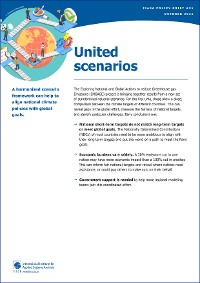
Policy Brief #31, October 2021. A harmonized scenario framework can help to align national climate policies with global goals.
 © IIASA
© IIASA
Policy Brief #31, cover
The Exploring National and Global Actions to reduce Greenhouse gas Emissions (ENGAGE) project is bringing together results from a new set of standardized national scenarios. For the first time, these allow a direct comparison between the climate targets of different countries. This can reveal gaps in the global effort, measure the fairness of national targets, and identify particular challenges. Early conclusions are:
- National short-term targets do not match long-term targets or meet global goals. The Nationally Determined Contributions (NDCs) of most countries need to be more ambitious to align with their long-term targets and put the world on a path to meet the Paris goals.
- Economic burdens vary widely. A 30% emissions cut in one nation may have more economic impact than a 100% cut in another. This can inform fair national targets and reveal where nations need assistance, or could pay others to make cuts on their behalf.
- Government support is needed to help more national modeling teams join this coordinated effort.
Reaching global goals requires national action
Meeting the global climate goals of the Paris Agreement requires action at a national level. Tailor-made national scenarios are valuable for informing climate policies, but they are difficult to compare. They all have different assumptions, and are rarely published in open academic papers.
The ENGAGE project is developing and comparing a new set of standardized national scenarios. According to this framework, each country should run one business-as-usual scenario plus a set of climate mitigation scenarios spanning a wide range of cuts in 2050 – ideally in 10% increments all the way from 10% to 100% (relative to emissions in 2010).
Using such standardized scenarios enables a fair comparison of each nation’s energy and land-use systems under a given level of mitigation, which brings several benefits.
Falling short
Such comparisons reveal that short-term policies do not match long-term mitigation ambitions.
A report by the ENGAGE project for the European commission compares standardized sets of scenarios from nine countries. Each set includes one deep mitigation scenario, which follows the country’s published long-term mitigation strategy, if that exists; otherwise it uses a target based on income (100% emissions cut for high-income countries, 80% for middle income, and 50% for low-income).
The team shows that if every country were to follow these long-term deep mitigation pathways, global emissions would be low enough to meet the Paris goal of keeping warming to well below 2°C (based on results from a global integrated assessment model, IMAGE).
For each country, the team also ran a scenario that follows its short-term climate commitments up to 2030: the unconditional nationally determined contributions (NDCs). In seven of the nine countries, these NDCs are clearly inconsistent with the deep mitigation pathways, in some cases with a very large emissions gap. If every country follows its existing unconditional NDCs, that would lead to global emissions far above the trajectory required for 2°C (Figure 1).
Economic imbalances
A given level of mitigation has very different economic impacts in different countries.
An IIASA-led study reports the effect of mitigation on GDP for six countries: China, India, Japan, Korea, Thailand, and Vietnam. The differences are stark. For example, India is projected to face a higher GDP loss to reach a target of only 30% than Korea faces to reach 100% (Figure 2). This could be used to judge economic fairness, for example, revealing what emissions reductions in a developing nation would be economically equivalent to carbon neutrality in wealthier countries.
This type of insight can also reveal where special solutions are needed. For example, in the study, some countries see high GDP impact for even modest levels of mitigation.
Where that is in a developing country, international cooperation and assistance may be required. If costs are especially high in a wealthy nation, a different solution is suggested. Research found that in Japan, targets close to 100% were very difficult to achieve with projected carbon prices reaching US$500 because of the country’s limited potential for solar and wind power (Figure 3). In this case, Japan could outsource its mitigation efforts, financially supporting other countries to make more cost-effective emission cuts on its behalf.
These early results also show that the most cost-effective approach to mitigation will vary a lot. The nine countries compared in a separate study all have very different projected energy mixes in 2050. Some countries are projected to get much of their low-carbon energy from biomass, nuclear, or hydropower rather than from solar and wind.
Wider engagement
The ENGAGE project will expand this framework to more countries in the future. As well as extending the benefits described above, this could act as a spur for some nations to improve their modeling capability and look at deeper cuts than they might otherwise have considered – potentially revealing that an ambitious target is more achievable than expected.
To help accomplish this wider participation, the ENGAGE project is running capacity-building workshops and a research exchange program – but support from governments will also be needed. A first step is simply talking to national modeling teams to ensure that they are engaging with the project. In some cases it will require further capacity-building and direct government funding.
 © Wikipedia
© Wikipedia
This project has received funding from the European Union’s Horizon 2020 research and innovation programme under grant agreement No 821471 (ENGAGE).
Disclaimer: the contents of this Policy Brief do not represent the opinion of the European Community nor is the European community responsible for any use that might be made of the content appearing herein.
ABOUT THE ENGAGE PROJECT
ENGAGE (Exploring National and Global Actions to reduce Greenhouse gas Emissions) is funded by the European Commission under Horizon 2020 (Grant Agreement No. 821471). It has a consortium of international and multidisciplinary leading research groups that aims to co-produce knowledge for designing cost-effective, technologically sound, socially, and politically feasible pathways that can meet the objectives of the Paris Agreement. ENGAGE will also quantify avoided climate change impacts at the regional and national levels and identify concrete policy portfolios that maximize co-benefits and minimize trade-offs.
IIASA Policy Briefs report on research carried out at IIASA and have received only limited review. Views or opinions expressed herein do not necessarily represent those of the institute, its National Member Organizations, or other organizations supporting the work.



